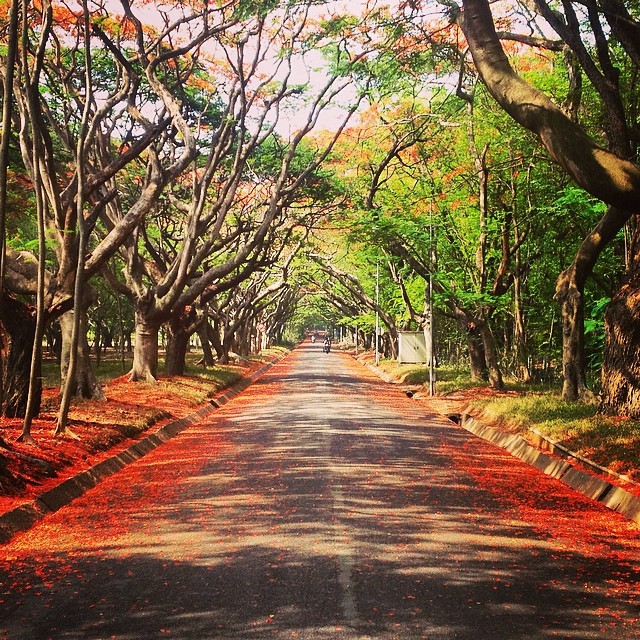How A 2 Hectare Forest In Bangalore’s Heart Has Lowered Temperature And Raised Its Water Table

The summer temperatures in Bangalore this year have been cause for particularly high concern among its residents, with some claiming that daytime temperature shot up to 41 degrees Celsius one day in April. This summer has surely felt hotter than most old Bangaloreans remember them ever being.
But, there are some parts of the city that have kept the unrelenting heat away. Walk around the lush Indian Institute of Science (IISc) Campus and you will encounter several species of trees, native and exotic. The 400 acre campus is home to 112 species of trees and 45 species of grasses. There are gulmohar lined avenues, large, raintree-shaded bowers, and colourful bursts of laburnum, jacaranda, and tabebuia.
And then you walk past the Centre for Ecological Sciences department (CES) and you stop short! The vegetation here is unlike anything you’ve encountered on the rest of the campus so far. Gigantic, woody vines weave endlessly like lace through a lush canopy, the trees are thick and dense, letting only a modicum of sunlight through, and all around you, in the cool air is the hum of insects and birds. If you feel like you are in the rainforests of Agumbe, you’re not alone.
The mini-forest
You are in IISc’s mini-forest, a forest planted by a team of researchers led by senior faculty member Dr T V Ramachandra (Energy and Wetlands Research Group). The man-made forest began as an experiment to study the adaptability of tree species endemic to the Western Ghats to a habitat and conditions considered alien to these species. It was also done to conserve native woodland trees and study their adaptability to afforestation programmes in urban spaces.
To do this, 500 saplings of 49 species were planted in 2 hectares land in the late 1980s. The region chosen was scrub jungle infested with parthenium weed and an annual rainfall of just 850 mm compared to the 6000 mm received by the Western Ghats.
The terrain on which the mini-forest was raised. (Photo: Dr T V Ramachandra)
In less than 25 years, the mini-forest transformed into a lush jungle of dense fruit and flowering trees which have had a positive impact on the micro-climate of the campus. Some of the species thriving there include mahua, arjuna, hirik, ylang-ylang, and the lovely liana, found only in the moist tropical forests of the Ghats.
Says Dr Ramachandra, “Temperature in the IISc campus is lower by 2 degrees Celsius compared to the rest of Bangalore city and it experiences increased humidity. The soil has enriched humus content owing to the many moist evergreen species and their good canopy cover. The forest has also raised the formerly 200 — foot deep water table of IISc to just 10 feet as trees have helped the percolation of water and aquifer recharge.”
The liana creeper (Photo: Author)
Because the mini-forest is free from human disturbance, it shelters 4 families of the elusive Slender Loris, many bird and reptile species, and smaller flora such as mosses, algae, fungi, and ferns. “The entire plot is amazingly transformed into the type of a habitat that prevails in the moist forests of Western Ghats”, says the scientist.
(Left) Holigarna arnottiana Hook. f. and (right) Syzygium laetum (Buch.-Ham.) Gandhi (Photo: Dr T V Ramachandra)
Relevance of the mini-forest for urban afforestation programmes
Dr Ramachandra’s studies show evidence of an ‘urban heat island phenomenon’ in Bangalore, a large number of localities with higher local temperatures. The pattern of growth in Bangalore (1005% increase in built-up area during 1973 to 2016) has had an impact on local climate (an increase of 2 to 2.5 ºC during the last decade) and natural resources with the loss of 78% vegetation and 79.5% loss in water bodies. “Indiscriminate felling of trees in newly formed layouts and for road widening is responsible for decline in tree cover in the city. Urban sprawl or unplanned expansion of urban centres by private developers has also restricted the future growth of the city. But, with the mini-forest experiment, we have proved that increasing tree cover can raise the water table and have a favourable impact on a region’s micro-climate," he says.
We need to create more such mini-forests in urban areas. If we reach 33 percent green cover in the city (as per GoI norms), we will then have 1 tree for every resident. Now, we are at 1 tree for 7 persons!
The mini-forest experiment can be replicated to create green pockets in other urban spaces as arboretums to conserve indigenous trees and provide habitats to several species of flora and fauna. These green spaces act also as carbon sinks, sequestering atmospheric carbon, lowering temperature, and mitigating climate change issues. A variant of the IISc mini-forest model was implemented at K.K. High School in Varthur following which the water table in the school has risen to 450 feet while in the rest of Varthur region, the water table stands at 900–1200 feet.
We need to create more such mini-forests in urban areas. If we reach 33 percent green cover in the city (as per GoI norms), we will then have 1 tree for every resident. Now, we are at 1 tree for 7 persons!
The Central Government announced earlier this month its plan to spend $6 billion on increasing India’s forest cover but unless citizens actively participate in these reforestation efforts, the trees will only exist in government files.
Maya is a social researcher by training. Her writing has appeared in Scroll, YourStory and The Alternative. She is the Founder of Eartha and tweets @Maya_Kilpadi.









